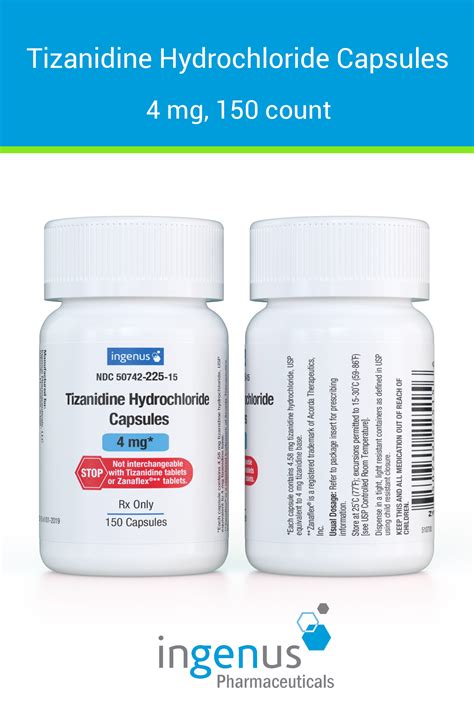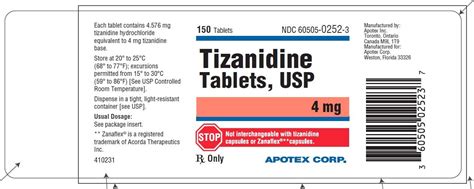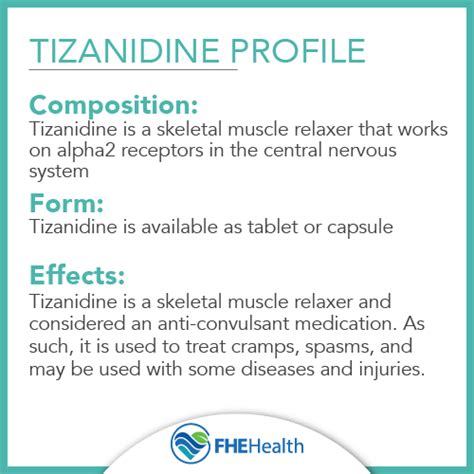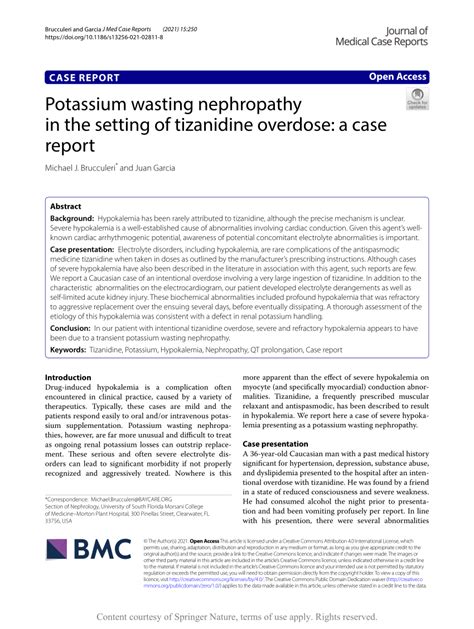Intro
Tizanidine works as a muscle relaxant, relieving spasms and tension with its skeletal muscle relaxant properties, also treating conditions like multiple sclerosis and spinal injury.
Muscle relaxants are a crucial part of managing various musculoskeletal conditions, including multiple sclerosis, spinal cord injuries, and muscle spasms. Among the numerous muscle relaxants available, Tizanidine has gained significant attention for its efficacy in treating muscle spasms. Understanding how Tizanidine works and its benefits can help individuals make informed decisions about their treatment options.
Tizanidine is a central alpha-2-adrenergic receptor agonist, which means it works by stimulating certain receptors in the brain and spinal cord. This stimulation leads to a decrease in the release of certain neurotransmitters that cause muscle spasms. As a result, Tizanidine helps to relieve muscle spasms, tightness, and stiffness, making it an effective treatment for conditions such as multiple sclerosis and spinal cord injuries.
The importance of managing muscle spasms cannot be overstated. Muscle spasms can significantly impact an individual's quality of life, causing pain, discomfort, and limited mobility. If left untreated, muscle spasms can lead to further complications, such as muscle atrophy and decreased range of motion. Therefore, it is essential to explore treatment options that can effectively manage muscle spasms and improve overall well-being.
Tizanidine Mechanism of Action

The benefits of Tizanidine are numerous. Not only does it provide effective relief from muscle spasms, but it also has a relatively fast onset of action, with effects typically felt within 1-2 hours of administration. Additionally, Tizanidine has a relatively short half-life, which means it is quickly eliminated from the body, reducing the risk of accumulation and side effects.
Benefits of Tizanidine
The benefits of Tizanidine can be summarized as follows: * Effective relief from muscle spasms and tightness * Fast onset of action, with effects typically felt within 1-2 hours * Relatively short half-life, reducing the risk of accumulation and side effects * Can be used to treat a range of conditions, including multiple sclerosis and spinal cord injuries * Available in various formulations, including tablets and capsulesTizanidine Uses

In addition to its primary uses, Tizanidine has also been investigated for its potential in treating other conditions, such as fibromyalgia and chronic pain. While more research is needed to fully understand its effects in these areas, the available evidence suggests that Tizanidine may be a useful adjunctive treatment for individuals experiencing chronic pain and muscle spasms.
Tizanidine Side Effects
As with any medication, Tizanidine can cause side effects. The most common side effects include: * Drowsiness * Dizziness * Weakness * Dry mouth * Constipation * Nausea and vomitingIt is essential to note that Tizanidine can also cause more severe side effects, such as hypotension, bradycardia, and hallucinations. Individuals taking Tizanidine should be closely monitored for these side effects and report any concerns to their healthcare provider.
Tizanidine Dosage

It is essential to follow the prescribed dosage and administration schedule to minimize the risk of side effects and ensure optimal efficacy. Individuals taking Tizanidine should also be aware of the potential for withdrawal symptoms if the medication is suddenly stopped. A gradual tapering of the dose is recommended to minimize the risk of withdrawal symptoms.
Tizanidine Interactions
Tizanidine can interact with other medications, including: * Fluvoxamine * Ciprofloxacin * Anti-hypertensive medications * Sedatives and hypnoticsThese interactions can lead to increased side effects, reduced efficacy, or other adverse effects. Individuals taking Tizanidine should inform their healthcare provider about all medications they are taking, including prescription and over-the-counter medications, vitamins, and supplements.
Tizanidine Contraindications

Individuals with certain medical conditions, such as hypotension, bradycardia, or renal impairment, should use Tizanidine with caution and under close medical supervision.
Tizanidine Warnings
Tizanidine can cause: * Hypotension and bradycardia * Hallucinations and psychotic episodes * Withdrawal symptoms if suddenly stopped * Interaction with other medicationsIndividuals taking Tizanidine should be aware of these warnings and report any concerns to their healthcare provider.
Tizanidine Overdose

Treatment for overdose typically involves supportive care, such as monitoring vital signs and providing respiratory support. In severe cases, activated charcoal or gastric lavage may be used to reduce absorption.
Tizanidine Abuse
Tizanidine has a potential for abuse, particularly when used in combination with other central nervous system depressants. Individuals taking Tizanidine should be aware of the risks of abuse and use the medication only as directed.Tizanidine Alternatives

These alternatives may have different mechanisms of action, side effect profiles, and dosing regimens. Individuals should consult with their healthcare provider to determine the best treatment option for their specific condition.
Tizanidine Patient Education
Individuals taking Tizanidine should be aware of the following: * Take the medication as directed * Do not suddenly stop taking the medication * Report any side effects or concerns to their healthcare provider * Be aware of potential interactions with other medications * Use caution when driving or operating heavy machineryBy following these guidelines and working closely with their healthcare provider, individuals can maximize the benefits of Tizanidine while minimizing the risks.
What is Tizanidine used for?
+Tizanidine is used to treat muscle spasms caused by conditions such as multiple sclerosis, spinal cord injuries, and stroke.
How does Tizanidine work?
+Tizanidine works by stimulating alpha-2-adrenergic receptors in the brain and spinal cord, leading to a decrease in the release of excitatory neurotransmitters that cause muscle spasms.
What are the common side effects of Tizanidine?
+The most common side effects of Tizanidine include drowsiness, dizziness, weakness, dry mouth, constipation, and nausea and vomiting.
Can Tizanidine be used in combination with other medications?
+Tizanidine can interact with other medications, including fluvoxamine, ciprofloxacin, anti-hypertensive medications, sedatives, and hypnotics. Individuals taking Tizanidine should inform their healthcare provider about all medications they are taking.
What should individuals do if they experience side effects while taking Tizanidine?
+Individuals who experience side effects while taking Tizanidine should report them to their healthcare provider. The healthcare provider may adjust the dosage or recommend alternative treatments.
In summary, Tizanidine is a muscle relaxant that works by stimulating alpha-2-adrenergic receptors in the brain and spinal cord. It is used to treat muscle spasms caused by conditions such as multiple sclerosis, spinal cord injuries, and stroke. While Tizanidine can cause side effects, it is generally well-tolerated and effective in managing muscle spasms. Individuals taking Tizanidine should be aware of the potential interactions with other medications and report any side effects or concerns to their healthcare provider. By working closely with their healthcare provider, individuals can maximize the benefits of Tizanidine while minimizing the risks. We invite you to share your thoughts and experiences with Tizanidine in the comments below. If you found this article informative, please share it with others who may benefit from this information.
